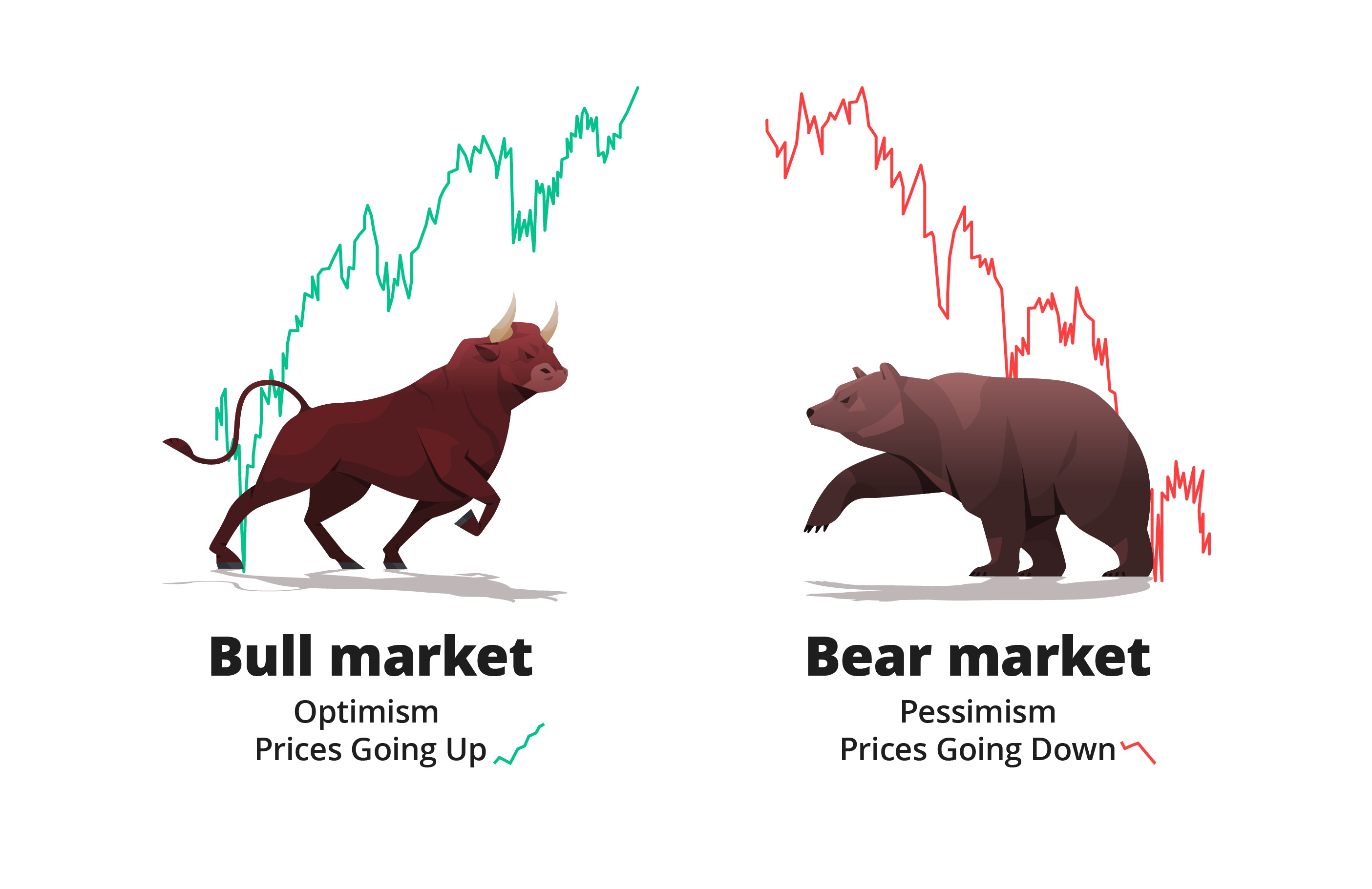Investing during a bear market
By Navin Sregantan
![]()
If you’ve only got a minute:
- A market is said to be in bear territory when securities or stock market indexes fall by at least 20% from their recent highs.
- History has shown that bear markets often don’t last as long as bull markets do.
- A bear market might not seem like the best time to invest but there are usually opportunities for investors provided they stick to best practices like investing in quality companies and staying long-term.
![]()
The decade that followed the Global Financial Crisis in 2009 was one where financial markets enjoyed a sustained period of growth. But since the global lockdowns triggered by the Covid-19 outbreak in March 2020, markets have experienced heightened volatility, characterised by more pronounced price swings in both directions.
As of April 7, 2025, the S&P 500, a key indicator of US stock market performance, had fallen 17.6% from its recent high on February 19, 2025, even briefly entering bear market territory during the April 7 trading session. This decline coincided with US President Donald Trump's "Liberation Day" tariff salvo, which unsettled markets.
Similarly, Singapore's Straits Times Index (STI) tumbled 10.9% from its recent high on March 28, 2025 when it reached the 4,000-point milestone during the day’s trading session.
The recent sharp global selloffs and the resulting "sea of red" in stock markets and portfolios are understandably concerning for investors, even causing panic in some cases. At the same time, those who were thinking of investing but have always harboured a fear of financial markets, may feel dissuaded from starting.
That said, bearish markets often present opportunities for both new and experienced investors. Given that it is always darkest before dawn, it might be an opportune time for those who think long-term to consider making investments in quality companies or financial products.
What is a bear market?
A market is said to be in bear territory when securities or stock market indexes fall by at least 20% from their recent highs. This is accompanied by negative investor sentiment and pessimism over economic growth.

Likewise, a bull market is said to be in play when stock market indexes recover 20% over a sustained period from its recent low. Investor sentiment is usually buoyant and economic growth is on the up.
While a bear market signifies a prolonged downturn, a market correction is often a shorter, sharper decline of between 10% and 20% from a recent peak. Market corrections are relatively common and often temporary, but it can precede a bear market.
Bear markets don’t last as long as bull markets
There have been similar occurrences of bull and bear markets in history, and it is interesting to note that bear markets often don’t last as long as bull markets do. Taking the S&P 500 as an example, a typical bear market lasts just over 9.5 months while bull markets last for an average of 2.7 years.
Moreover, markets have historically shown resilience after significant downturns. For example, after the 2020 selloffs, many markets rebounded strongly, often reaching new highs within 18 months. This was evident in the post-Covid-19 period, with the S&P 500 gaining 28.7% in 2021.
Similarly, following the S&P 500’s 19.4% loss in 2022 due to inflationary pressures, aggressive interest rate hikes by the US Federal Reserve, and geopolitical uncertainty due to the war in Ukraine, markets have again demonstrated the potential for recovery, gaining 24.2% in 2023.
In other words, financial markets spend more time experiencing a sustained period on the up rather than down. This sounds positive for long-term investors, right? As such, it is worth re-assessing the risk-reward of putting fresh funds to work.

What to take note of before investing
Before investing, ensure that you’ve built up your emergency fund. Aim to have at least 3 to 6 months of emergency cash, or more if you have dependants. If you are self-employed or in the gig economy, you should target having at least 12 months of emergency savings.
The next step is to evaluate your risk profile as your investment assets should reflect your risk appetite. They include bonds, stocks, exchange-traded funds (ETFs) and unit trusts, among others.
After securing this financial safety net, consider investing your remaining funds wisely. If you are just starting out and do not have sufficient funds for effective lump-sum investing - it typically requires somewhere between S$1,000 and S$5,000 per security - there are more affordable options available.
For example, you can consider investing through DBS Invest-Saver which lets you invest a fixed sum at regular intervals from S$100 a month. This style of investing is called dollar-cost averaging (DCA), where investment takes place regularly regardless of market conditions, so you accumulate more units when prices are low and less units when prices are high.
If you're uncertain about where to invest, consider ready-made digital investment solutions like DBS digiPortfolio where you can choose from investment portfolios across varying risk profiles that are managed by a team of DBS portfolio managers.
Whatever option you choose, remember to only invest the amount that you can afford to do without in the short term as investing comes with risks and needs time to grow. Do your due diligence and understand the investment products before going ahead and adopt a diversified approach.
Read more: Investing with robo-advisors
Find out more about: DBS digiPortfolio

What should investors look out for?
On the surface, a bear market might not seem like the best time to invest but there are usually opportunities for investors provided they stick to best practices.
Focus on quality
Accumulating stocks of stable and reputable companies with strong fundamentals during a bear market could be a good strategy for long-term investments as many of them might be trading below their fair value. In other words, you should focus on quality companies or pooled investment products (e.g. ETFs and unit trusts) that focus on investing in them.
Granted, during market downturns, almost all companies face selloffs. However, those that have taken on too much debt or don't have competitive advantages (i.e. not producing unique products) tend to get hit the hardest, while high-quality companies tend to fare better.
For a start, you can look at defensive stocks. They are typically large-cap companies with strong balance sheets that hold up well during recessions.
Read more: Investment terms and metrics to learn
Stay long-term
When investing during a bear market, having a long-term view is crucial for building your portfolio. Bear markets require holding power, as predicting market bottoms or recovery timelines is very difficult.
Your time horizon influences potential returns and suitable investment options. By adopting a long-term lens, you recognise that most stocks deliver returns over time, reflecting overall economic growth and the accumulated profits of companies, which ultimately benefit shareholders.
This also means steering the course and staying invested during periods of uncertainty. For retail investors, consistently timing the market to "buy low, sell high" is difficult, and even professional investors sometimes misjudge the market.
Instead of trying to “time the market” and dealing with the unpredictability of market fluctuations, think long-term and spend “time in the market” by employing a DCA strategy.
If you’re always trying to “time the market”, there is a good chance that you’ll miss the best trading days.

Based on the returns of the S&P 500, which serves as the benchmark for US stock market performance, between 2005 and 2024, 7 of the 10 best days occurred within 2 weeks of the 10 worst trading days.
In other words, by not having skin in the game, you might miss out the days that have the best returns.
Read more: Is DCA or lump-sum investing better for you?
Find out more about: DBS Invest-Saver
Be steady
Don’t yield to the temptation of trying to “time the market” to buy at the bottom, especially during periods of uncertainty.
It is advisable to focus on buying stocks or funds because you want to own the business and/or believe a particular market or sector has long-term prospects, even if prices dip after you buy.
Instead of trying to find the bottom and investing all your funds at once, it helps to view investing during a bear market as an opportunity to build positions over time. Doing so allows you to build your existing stock and/or fund investments gradually over time.
One of the benefits of doing this is that if the securities you have bought performed poorly, you'll be able to take advantage of the new lower prices to further build on your long-term positions.
Overall, what ties this strategy together is knowing your risk tolerance and using the appropriate financial metrics (e.g. price-to-earnings ratio, price-to-book ratio) to help you make decisions. You can also use technical indicators to ensure that you make purchases within a reasonable price range to maximise your long-run profits.
How can you go about it?
Consider adopting a hybrid approach by using DCA to build your base slowly and steadily, while adding more funds into the investment in an ad-hoc manner as and when market opportunities arise.
Ultimately, sound investment strategies and the discipline to adhere to a well-defined plan are key drivers of portfolio returns over the long run.
Read more: Fundamental vs technical analysis
In summary
Whether you are a new investor or looking out for investment opportunities during a bear market or market correction, be sure to invest after setting aside emergency cash, and start taking the next steps to grow your wealth.
As markets tend to be choppy when in bear territory, it is important to think long-term and focus on quality investments.
For those who are already in the market, investing during a bear market can be a way to supplement your other investments as part of a long-term strategy.
Ready to start?
Need help selecting an investment? Try ‘Make Your Money Work Harder’ on digibank to receive specific investment picks based on your objectives, risk profile and preferences.
Invest with DBS Invest with POSB
Speak to the Wealth Planning Manager today for a financial health check and how you can better plan your finances.
Sources:
DBS Chief Investment Office, “Risk assets look rewarding on a 12-month time frame,” (2022, Jun 3) Retrieved 21 Jun 2022.
Disclaimers and Important Notice
This article is meant for information only and should not be relied upon as financial advice. Before making any decision to buy, sell or hold any investment or insurance product, you should seek advice from a financial adviser regarding its suitability.
All investments come with risks and you can lose money on your investment. Invest only if you understand and can monitor your investment. Diversify your investments and avoid investing a large portion of your money in a single product issuer.
Disclaimer for Investment and Life Insurance Products








That's great to hear. Anything you'd like to add? (Optional)
We’re sorry to hear that. How can we do better? (Optional)